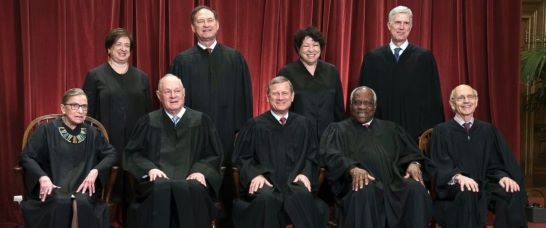“Democrats are warning Republicans not to fill a possible Supreme Court vacancy this year after denying President Barack Obama the chance in 2016, saying it would embolden a push on the left to add seats to the court,” NBC News said on Monday, Aug. 3, 2020, under the headline, “Democrats warn GOP: Don’t fill a Supreme Court vacancy in 2020 or we’ll retaliate.” Read story here.
In 2016, Republican senators led by Mitch McConnell blocked Obama’s appointment of Merrick Garland for more than a year to keep the seat open in case Trump won the election, which he did. Conservative Neil Gorsuch got that seat, vacated by the death of conservative justice Anthony Scalia. The episode angered Democrats.
Trump filled a second vacancy with conservative Brett Kavanaugh, whose confirmation hearings turned explosive, when Anthony Kennedy, the court’s swing vote, retired. Democrats had no chance of keeping Trump from appointing a conservative, but especially loathed Kavanaugh for his role in the Bill Clinton impeachment and other reasons.
But even more than lingering bitterness from the Garland and Kavanaugh episodes, Democrats fear another Trump appointee would upset the court’s tenuous balance, swing its rulings sharply rightward, and lead to overturning Roe v. Wade abortion rights.
To the surprise of many court watchers, Trump’s appointment of two conservative justices didn’t quite achieve that goal, because the Bush-appointed chief justice, John Roberts, has swung to the center on key issues. Most famously, in 2012, he cast the deciding vote in the 5-4 decision upholding Obamacare, which continues to grow in public acceptance and popularity.
With 87-year-old justice Ruth Bader Ginsburg seriously ailing from liver cancer, alarmed progressives floated the idea of enlarging the court from 9 to 13 seats to thwart any conservative majority Trump might achieve, and idea Democrats have resisted until now.
The Constitution, in Article III, created the Supreme Court but doesn’t specify the number of judges, which Congress can change with legislation passed by simple majorities.
Essentially all Republican senators with a say in the matter have vowed to fill a vacancy if one occurs this year, giving Trump a third Supreme Court appointment, even though the election is now only 3 months away and a new president will take office in less than 6 months. GOP senator Chuck Grassley, a former Judiciary Committee chairman, opposes that but he doesn’t control it.
All of this becomes moot if Trump wins another term, but he’s trailing far behind Biden in polls, and is now almost universally expected to lose the election unless something changes. Republicans, looking at the political situation, foresee a possibility of not only losing the White House but also the Senate, which leave them unable to block a President Biden’s appointments to the Supreme Court.
If that happens, not only would Ginsburg be replaced by another liberal, but conservative justice Clarence Thomas, who also is aging and ailing, might be, too — swinging the court’s balance back to a 5-4 liberal majority, if Roberts is counted as a conservative. (He still is in many respects, but is independent on some issues, including conservatives’ holy grail of overturning abortion rights.)
The GOP’s Supreme Court strategy now depends on retaining a Senate majority if they can’t keep Trump in office. If they can’t do that, either, here’s the dilemma they’ll face: If they confirm a lame-duck appointment by Trump, then Democrats could neutralize it by expanding the court, and might be angered enough by the baldfaced partisan hypocrisy of such a move to do so.
But that would require passing legislation, and to do that, Democrats would have to eliminate the Senate filibuster, which they could do with a simple majority, because that’s merely a rule change, not legislation. That would eliminate a GOP Senate minority’s ability to block any other legislation as well, an option they definitely will want to retain if Democrats win control of the White House and both houses of Congress.
(It should be noted that while Biden would take office on Jan. 20 if he wins, the new Congress will be sworn in Jan. 3, so Trump will lose his ability to confirm appointments on the latter date, if his party loses Senate control in the Nov. 3 elections. Ginsburg only has to hang on until then.)
By this complex political calculus, Republicans clearly will be better off to not mess with the Democrats if another Supreme Court vacancy occurs. But by all indications, they’re knee-jerking, not thinking logically. It remains to be seen whether the Democrats would actually expand the court, until now only a progressive dream. But the Republican attitude has now prompted them to make the threat, and it’s probably not an empty one. Professional politicians don’t make empty threats, any more than generals do. Republicans ought to take it seriously, because a 13-seat Supreme Court would likely mean Biden would appoint at least 6 new justices, as it’s unlikely either Ginsburg or Thomas will still be there in 2024.
Photo: Will 9 chairs and 9 fake smiles become 13 chairs and 13 fake smiles? Stay tuned.

This is much ado about nothing. If Trump gets the opportunity to nominate he should do so, and the Republican Senate should advise and consent.
If they want to be cagey they do it after the election. To place additional judges on the Supreme Court should Trump win would mean over coming a Presidential veto. They could do
Republicans will put more justices on the Supreme Court if they can, but that depends on a vacancy occurring, and timing is critical. If Trump loses but they keep the Senate, they have until Jan. 19; if they don’t, they have until Jan. 2. As this article points out, if Trump seats another justice, the Democrats might respond by packing the court. That’s “much ado about nothing” only if Trump wins and his party keeps the Senate or Democrats take over before there’s a vacancy.